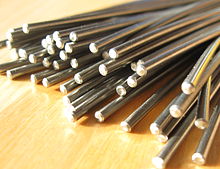
Back نيتينول Arabic Nitinol AZ نیتینول AZB Нитинол Bulgarian নাইটিনল Bengali/Bangla Nitinol Catalan نیتینۆڵ CKB Nitinol German Nitinol Spanish نایتینول FA
 Nitinol wires | |
| Material properties | |
|---|---|
| Melting point | 1,310 °C (2,390 °F) |
| Density | 6.45 g/cm3 (0.233 lb/cu in) |
| Electrical resistivity (austenite) | 82×10−6 Ω·cm |
| (martensite) | 76×10−6 Ω·cm |
| Thermal conductivity (austenite) | 0.18 W/cm·K |
| (martensite) | 0.086 W/cm·K |
| Coefficient of thermal expansion (austenite) | 11×10−6/°C |
| (martensite) | 6.6×10−6/°C |
| Magnetic permeability | < 1.002 |
| Magnetic susceptibility (austenite) | 3.7×10−6 emu/g |
| (martensite) | 2.4×10−6 emu/g |
| Elastic modulus (austenite) | 75–83 GPa |
| (martensite) | 28–40 GPa |
| Yield strength (austenite) | 195–690 MPa |
| (martensite) | 70–140 MPa |
| Poisson's ratio | 0.33 |
| Nitinol properties are particular to the precise composition of the alloy and its processing. These specifications are typical for commercially available shape memory nitinol alloys | |
Nickel titanium, also known as nitinol, is a metal alloy of nickel and titanium, where the two elements are present in roughly equal atomic percentages. Different alloys are named according to the weight percentage of nickel; e.g., nitinol 55 and nitinol 60.
Nitinol alloys exhibit two closely related and unique properties: the shape memory effect and superelasticity (also called pseudoelasticity). Shape memory is the ability of nitinol to undergo deformation at one temperature, stay in its deformed shape when the external force is removed, then recover its original, undeformed shape upon heating above its "transformation temperature." Superelasticity is the ability for the metal to undergo large deformations and immediately return to its undeformed shape upon removal of the external load. Nitinol can deform 10 to 30 times as much as ordinary metals and return to its original shape. Whether nitinol behaves with the shape memory effect or superelasticity depends on whether it is above its transformation temperature. Below the transformation temperature it exhibits the shape memory effect, and above that temperature it behaves superelastically.